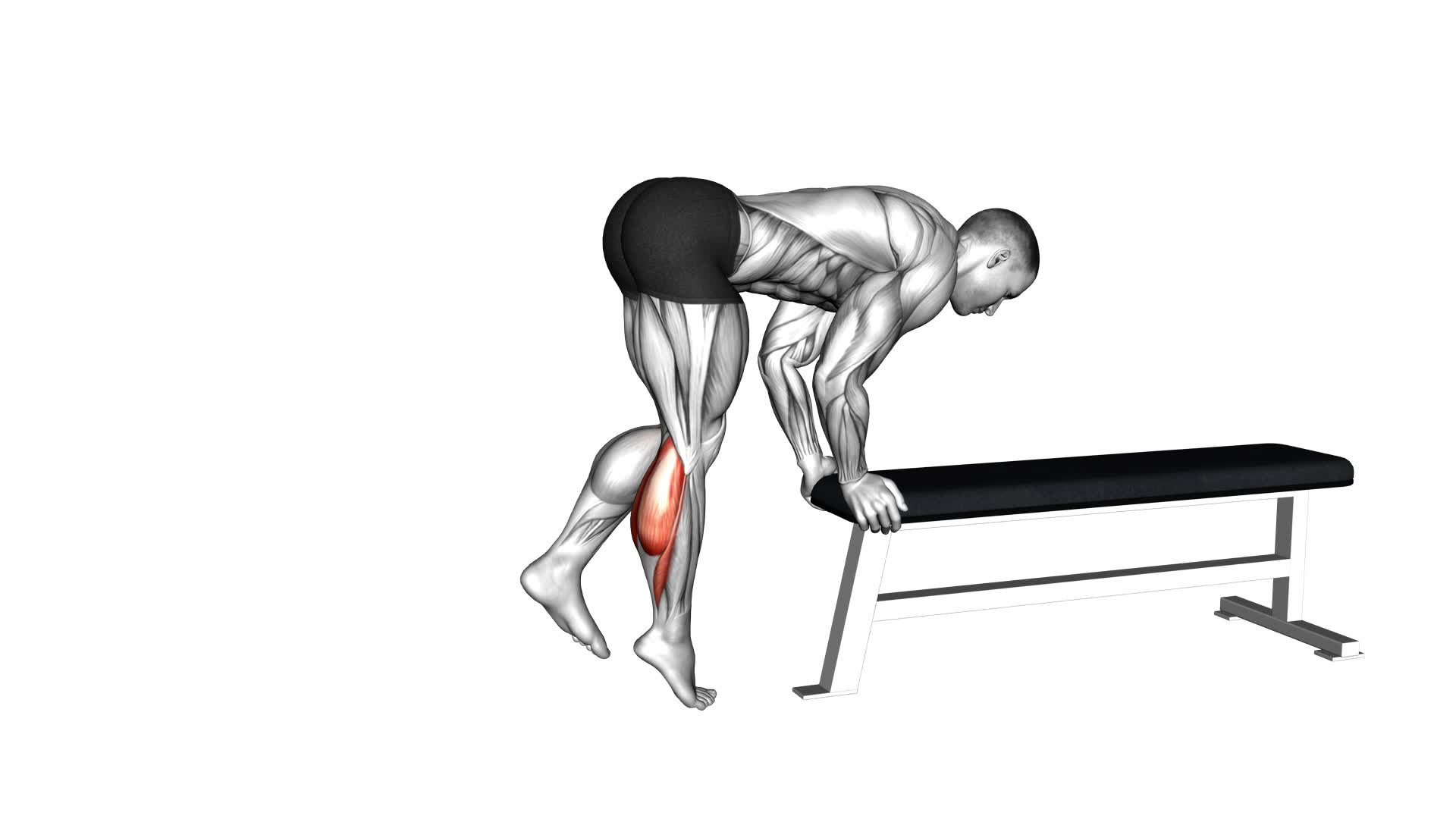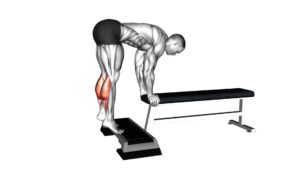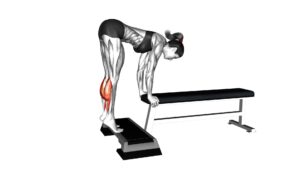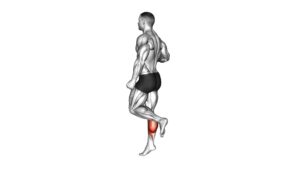One Leg Donkey Calf Raise – Video Exercise Guide & Tips

Are you looking to strengthen your calf muscles and improve your balance? Then the one leg donkey calf raise is the exercise for you!
Watch This Exercise Video
In this video exercise guide, we'll show you the proper form and technique for beginners, as well as advanced variations to challenge yourself.
We'll also share common mistakes to avoid and tips for maximizing your results.
Get ready to take your calf workout to the next level with this effective and efficient exercise.
Let's get started!
Key Takeaways
- The one leg donkey calf raise improves balance and strengthens calf muscles.
- It targets the gastrocnemius and soleus muscles.
- The exercise can enhance athletic performance and can be done with or without equipment.
- Safety precautions for beginners include warming up calf and leg muscles, using a stable surface, engaging core muscles for stability, and controlling the movement.
Benefits of the One Leg Donkey Calf Raise
Improve balance and strengthen your calf muscles with the One Leg Donkey Calf Raise.
This exercise is highly effective for calf muscle activation and strengthening the lower leg muscles. By performing this exercise regularly, you can achieve stronger and more defined calves.
The One Leg Donkey Calf Raise specifically targets the gastrocnemius and soleus muscles in the calf. These muscles play a crucial role in maintaining stability and propelling the body forward during activities such as running, jumping, and walking. Strengthening these muscles can greatly improve your overall athletic performance.
To perform the One Leg Donkey Calf Raise, stand on the edge of a raised surface such as a step or a block. Place the ball of one foot on the edge, allowing your heel to hang off. Slowly raise your body up onto your toes, lifting your heel as high as possible. Hold for a moment, then lower your heel back down to the starting position. Repeat for the desired number of repetitions, then switch to the other leg.
Incorporating the One Leg Donkey Calf Raise into your workout routine can help you achieve stronger, more balanced calf muscles. This exercise is especially beneficial for athletes, runners, and anyone looking to improve their lower leg strength.
Equipment Needed for the Exercise
To perform the One Leg Donkey Calf Raise, you'll need a raised surface such as a step or a block. This elevated platform is essential as it allows for a greater range of motion and deeper contraction of the calf muscles. When choosing a raised surface, make sure it's sturdy and stable to ensure your safety during the exercise.
There are a few equipment options that you can use for this exercise. One option is a step platform, which is commonly found in gyms and fitness centers. These platforms are usually adjustable, allowing you to increase or decrease the height according to your preference. Another option is a sturdy block or a stack of stable objects like books or bricks. Just make sure that whatever you use is secure and won't shift or move during the exercise.
If you don't have access to a raised surface, there are alternative exercises you can do to target your calf muscles. Standing calf raises or seated calf raises are great options that can be done without any equipment. Additionally, you can use a calf raise machine if it's available at your gym. These machines provide a guided motion and allow you to adjust the weight resistance to suit your fitness level.
Proper Form and Technique for Beginners
When starting out with the one leg donkey calf raise, it's important to be aware of common beginner mistakes and take necessary safety precautions.
Some common mistakes include using too much weight, not maintaining proper alignment, and rushing through the exercise.
To prevent injury, make sure to start with a lighter weight, maintain proper form throughout the movement, and perform the exercise at a controlled pace.
Common Beginner Mistakes
To avoid common beginner mistakes, focus on maintaining proper form and technique while performing the One Leg Donkey Calf Raise. This exercise can be challenging, but with the right approach, you can overcome plateaus and modify it for different fitness levels.
One mistake beginners often make isn't engaging their core muscles. Remember to keep your core tight throughout the movement to ensure stability and prevent strain on your lower back.
Another common mistake isn't using a stable surface for support. Use a sturdy platform or step to rest your hands on while performing the exercise.
Lastly, avoid rushing through the movement. Take your time and perform the exercise with control to maximize its effectiveness.
Safety Precautions for Beginners
Ensure proper form and technique as a beginner by focusing on core engagement, using a stable surface for support, and performing the One Leg Donkey Calf Raise exercise with control.
Here are some safety precautions and beginner modifications to keep in mind:
- Warm up exercises: Prior to performing the One Leg Donkey Calf Raise, it's important to warm up your calf and leg muscles. Incorporate dynamic stretches such as ankle circles and leg swings to increase blood flow and flexibility.
- Start with a stable surface: As a beginner, it's recommended to perform this exercise on a stable surface, such as a step or a block, to maintain balance and stability.
- Engage your core: Proper core engagement during the exercise helps maintain stability and protects your lower back. Keep your abdominal muscles tight throughout the movement.
- Control the movement: Focus on performing the exercise with control rather than rushing through it. This helps prevent injuries and ensures that you're targeting the right muscles.
Advanced Variations to Challenge Yourself
You can challenge yourself further with advanced variations of the one leg donkey calf raise exercise. These advanced modifications are designed to push your training progressions and take your calf raises to the next level.
One advanced variation is the weighted one leg donkey calf raise. Instead of using just your bodyweight, you can hold a dumbbell or a weight plate against your chest while performing the exercise. This added resistance will increase the intensity and difficulty of the exercise, helping you build even stronger calves.
Another advanced variation is the explosive one leg donkey calf raise. In this variation, you'll perform the exercise with an explosive movement, pushing off forcefully and quickly during the raising phase. This not only challenges your calf muscles but also improves your explosive power and athletic performance.
Finally, you can also try performing the one leg donkey calf raise on an unstable surface, such as a balance board or a Bosu ball. This challenges your balance and stability, engaging more muscles in your lower body and core.
Remember to always start with the basic version of the exercise and gradually progress to the advanced variations as you become more comfortable and confident in your abilities. Keep challenging yourself and enjoy the benefits of stronger and more defined calf muscles.
Common Mistakes to Avoid
To avoid common mistakes when performing the one leg donkey calf raise, it's important to focus on proper form. Make sure to keep your back straight and engage your core throughout the exercise.
Additionally, be cautious not to overload with too much weight, as this can lead to injury.
Lastly, don't neglect calf flexibility, as tight calves can hinder your range of motion and limit the effectiveness of the exercise.
Proper Form Demonstration
Avoid arching your lower back when performing the one leg donkey calf raise to maintain proper form. Arching your lower back can put unnecessary strain on your spine and diminish the effectiveness of the exercise. Here are some common mistakes to avoid when performing this exercise:
- Leaning too far forward: This can shift the focus from your calves to your quads and reduce the effectiveness of the exercise.
- Using momentum: Avoid using momentum to lift your body up. Instead, focus on using the strength of your calf muscles to perform the movement.
- Neglecting proper range of motion: Make sure to fully extend your ankle at the top of the movement and lower your heel below the platform to engage your calves fully.
- Not controlling the descent: Control the descent of the movement to maximize muscle activation and prevent injury.
By avoiding these common mistakes, you can ensure proper form and get the most out of your one leg donkey calf raise. Remember to always listen to your body and adjust the exercise as needed to prevent any discomfort or injury.
For calf muscle development, the one leg donkey calf raise is an excellent exercise. However, if you're looking for alternative exercises, you can try standing calf raises, seated calf raises, or calf raises using a calf raise machine. These exercises target the calf muscles and can help you achieve your desired calf muscle development. Remember to consult with a fitness professional if you're unsure about the proper form or need assistance with any exercise.
Overloading With Weight
When overloading with weight during the one leg donkey calf raise, it's important to maintain proper form to prevent injury and maximize muscle activation. Overloading techniques are used to challenge the muscles and promote growth.
One common mistake to avoid is using too much weight too soon. It's important to gradually increase the weight over time to allow your muscles to adapt and prevent overexertion.
Another mistake to avoid is using momentum to lift the weight. This reduces the effectiveness of the exercise and increases the risk of injury. Instead, focus on using controlled movements and maintaining tension in the calf muscles throughout the exercise.
Neglecting Calf Flexibility
Neglecting calf flexibility can hinder your progress and increase the risk of injury during the one leg donkey calf raise. It's important to understand the calf muscle anatomy and the importance of calf strength. Here are four common mistakes to avoid when neglecting calf flexibility:
- Skipping warm-up exercises: Failing to properly warm up your calf muscles can lead to tightness and restricted range of motion during the exercise.
- Neglecting stretching exercises: Stretching your calf muscles before and after the one leg donkey calf raise helps improve flexibility and prevent muscle imbalances.
- Overlooking mobility exercises: Incorporating mobility exercises like ankle rotations and calf raises with a full range of motion can enhance flexibility and prevent injuries.
- Ignoring recovery techniques: Allowing enough time for rest and recovery is crucial for maintaining calf flexibility and preventing overuse injuries.
Tips for Maximizing Your Results
To get the most out of your One Leg Donkey Calf Raise, incorporate these tips to enhance your results.
Maximizing gains is all about pushing yourself to the limit and constantly challenging your muscles.
Firstly, vary the speed of your repetitions. By slowing down the movement on the eccentric (lowering) phase and exploding upwards on the concentric (lifting) phase, you can increase the intensity and effectiveness of this exercise.
Additionally, try incorporating variations to target different areas of your calf muscles. You can perform the exercise on a step or an elevated platform to increase the range of motion and engage your calf muscles more intensely. Another variation is to perform the exercise with a weighted backpack or holding a dumbbell for added resistance. This will help to further stimulate muscle growth and increase the difficulty of the exercise.
Finally, don't forget to focus on proper form and technique. Keep your core engaged, maintain a neutral spine, and avoid excessive swinging or bouncing.
Frequently Asked Questions
How Many Repetitions Should I Do for the One Leg Donkey Calf Raise?
To progress in the one leg donkey calf raise, start with a weight you can comfortably lift for 8-12 repetitions. As you get stronger, gradually increase the weight and aim for 3-4 sets of 10-15 repetitions.
This exercise targets your calf muscles, helping to build strength and definition. It also improves ankle stability and balance.
Remember to maintain proper form and consult a fitness professional if you have any concerns.
Can I Perform the One Leg Donkey Calf Raise Without a Donkey Calf Raise Machine?
Yes, you can definitely perform the one leg donkey calf raise without a donkey calf raise machine. There are alternative exercises that you can do to target your calf muscles effectively.
The one leg standing calf raise and the seated calf raise are great options. Performing the one leg donkey calf raise without a machine also has its benefits, such as improving balance, stability, and strengthening the muscles in your lower legs.
Is It Necessary to Warm up Before Doing the One Leg Donkey Calf Raise?
Before performing the one leg donkey calf raise, it's highly recommended to warm up your muscles. Warming up helps increase blood flow, flexibility, and reduces the risk of injury. It prepares your calves for the exercise by loosening up the muscles and joints.
Additionally, it's important to maintain proper form and technique during the exercise. This involves balancing on one leg, keeping your core engaged, and slowly raising and lowering your heel.
Can I Do the One Leg Donkey Calf Raise if I Have Knee or Ankle Injuries?
If you have knee or ankle injuries, it may not be advisable to do the one leg donkey calf raise. It could put excessive strain on these areas and worsen your condition.
However, there are alternative exercises and modifications that you can try to target your calf muscles without aggravating your injuries.
It's important to consult with a healthcare professional or a fitness trainer to find suitable exercises that won't cause further harm.
How Often Should I Incorporate the One Leg Donkey Calf Raise Into My Workout Routine?
To maximize the benefits of incorporating unilateral exercises into your workout routine, it's recommended to include the one leg donkey calf raise a few times a week.
This exercise helps improve balance, stability, and targets your calf muscles effectively.
Start with a moderate number of repetitions and gradually increase the difficulty by adding weights or elevating the surface you're standing on.
Remember to listen to your body and adjust the frequency according to your fitness level and recovery time.
Conclusion
In conclusion, the one leg donkey calf raise is a highly effective exercise for targeting and strengthening your calf muscles.
By utilizing proper form and technique, you can maximize the benefits of this exercise and avoid common mistakes.
Additionally, advanced variations can be incorporated to challenge yourself and further enhance your results.
Remember to start with the appropriate equipment and follow these tips to achieve the best possible outcome.

Author
Years ago, the spark of my life’s passion ignited in my mind the moment I stepped into the local gym for the first time. The inaugural bead of perspiration, the initial endeavor, the very first surge of endorphins, and a sense of pride that washed over me post-workout marked the beginning of my deep-seated interest in strength sports, fitness, and sports nutrition. This very curiosity blossomed rapidly into a profound fascination, propelling me to earn a Master’s degree in Physical Education from the Academy of Physical Education in Krakow, followed by a Sports Manager diploma from the Jagiellonian University. My journey of growth led me to gain more specialized qualifications, such as being a certified personal trainer with a focus on sports dietetics, a lifeguard, and an instructor for wellness and corrective gymnastics. Theoretical knowledge paired seamlessly with practical experience, reinforcing my belief that the transformation of individuals under my guidance was also a reflection of my personal growth. This belief holds true even today. Each day, I strive to push the boundaries and explore new realms. These realms gently elevate me to greater heights. The unique combination of passion for my field and the continuous quest for growth fuels my drive to break new ground.



